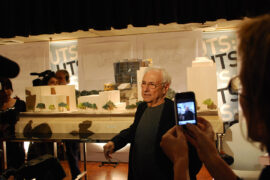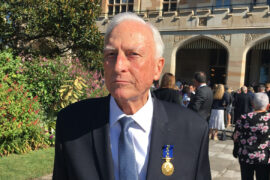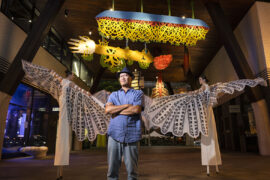Modern architecture would not be as it is today, if it weren’t for Art Gensler. We reflect on his remarkable built legacy, in the wake of the preeminent architect’s passing, 10 May, 2021.

June 2nd, 2021
If there’s one person we need to thank for bringing the focus of contemporary design to office interiors at a time when nobody cared much for it, it’s Art Gensler. Widely credited with creating the blueprint for how countless professional services firms organise and manage themselves today, the American architect died at the age of 85 on 10th May at his home in California.

Gensler, who went by Art, founded his namesake studio in 1965 with his wife, Drue, and one draftsman, James Follett. At the time, they only had S$200 in the bank and was working in the back of another architect’s office in San Francisco. From a single digit workforce, the studio grew rapidly with offices opening around the U.S. in the 70s and 80s, and then internationally in the 80s and 90s. Today, it’s one of the world’s largest architecture firms with 5,000 employees across 50 offices.
Says Andy Cohen, Gensler Co-CEO: “Art didn’t want to be a ‘starchitect.’ In fact, what he built was a constellation of stars by hiring smart people and getting out of their way. It’s why Gensler is a pioneer in our industry.” Indeed, his pioneering spirit, ‘inside-out’ approach to architecture and selfless client-first design approach laid the foundation for the human experience framework that his firm still embraces to this day. These values have helped propel Gensler to global prominence long after Art stepped down as CEO in 2005 and Chairman in 2010.

Not many can say that they have had an impressive career as an architect for 65 years. Yet, one of Art’s greatest legacies was his focus on having the firm pass seamlessly from one generation to the next. This model of a self-governing and self-sustaining business entity that would evolve and grow over time birthed many incredible projects throughout the firm’s history. From office interiors to megaprojects, here are some great works from the firm to mark Art’s passing.
While designers take up the tenets of biophilia for working and learning spaces, Gensler seeks out the zenith of minimalism in a futuristic light-sculpted convention hall for Hyundai. The intention was for optimum focus, free of distraction – imparting a futuristic aesthetic that communicates the essence of Hyundai’s minimalist yet forward-thinking brand.




We’ve got this project covered, here
In bringing 2000 Microsoft staff into a single location, Gensler has deconstructed the typical working model. Taking its client into unchartered territories, the design team envisaged a new working landscape that moves beyond the corporate norms to embrace ‘island’ life. Gensler’s concept translates ‘typical island components’ into a functional office.





We’ve got this project covered, here
In 2015, Shanghai’s skyline welcomed the second tallest tower in the world. The Shanghai Tower’s transparent skin was designed to humanise the building and embrace city life. Its spiral form, on the other hand, allows the building to withstand the typhoon-force winds that are common in Shanghai. With the aid of the world’s largest tuned mass damper, the building can also withstand an earthquake of up to 7.5 on the Richter scale. Cutting-edge sustainable strategies and innovative public spaces set new standards for green community and provide an inimitable experience for working and living in skyscrapers. The tower has been awarded a China Green Building Three Star rating and a LEED® Platinum Certification from the U.S. Green Building Council.


INDESIGN is on instagram
Follow @indesignlive
A searchable and comprehensive guide for specifying leading products and their suppliers
Keep up to date with the latest and greatest from our industry BFF's!

For a closer look behind the creative process, watch this video interview with Sebastian Nash, where he explores the making of King Living’s textile range – from fibre choices to design intent.

From the spark of an idea on the page to the launch of new pieces in a showroom is a journey every aspiring industrial and furnishing designer imagines making.

At the Munarra Centre for Regional Excellence on Yorta Yorta Country in Victoria, ARM Architecture and Milliken use PrintWorks™ technology to translate First Nations narratives into a layered, community-led floorscape.

We republish an article in memory of the late architect by UTS, whose Dr Chau Chak Wing Building was Gehry’s first built project in Australia. The internationally revered architect passed away on 5th December.

The Australian marketing and advertising community is mourning the loss of Murray Robert Pope, a distinguished marketing strategist and community leader who passed away peacefully at his home on October 20th, 2025.
The internet never sleeps! Here's the stuff you might have missed

Knoll unveils two compelling chapters in its uncompromising design story: the Perron Pillo Lounge Chair and new material palettes for the Saarinen Pedestal Collection.

Unveiled at Barangaroo South, Indonesian–Australian artist Jumaadi’s first permanent public artwork layers sculpture, sound and shadow to reimagine how art is encountered in the city.